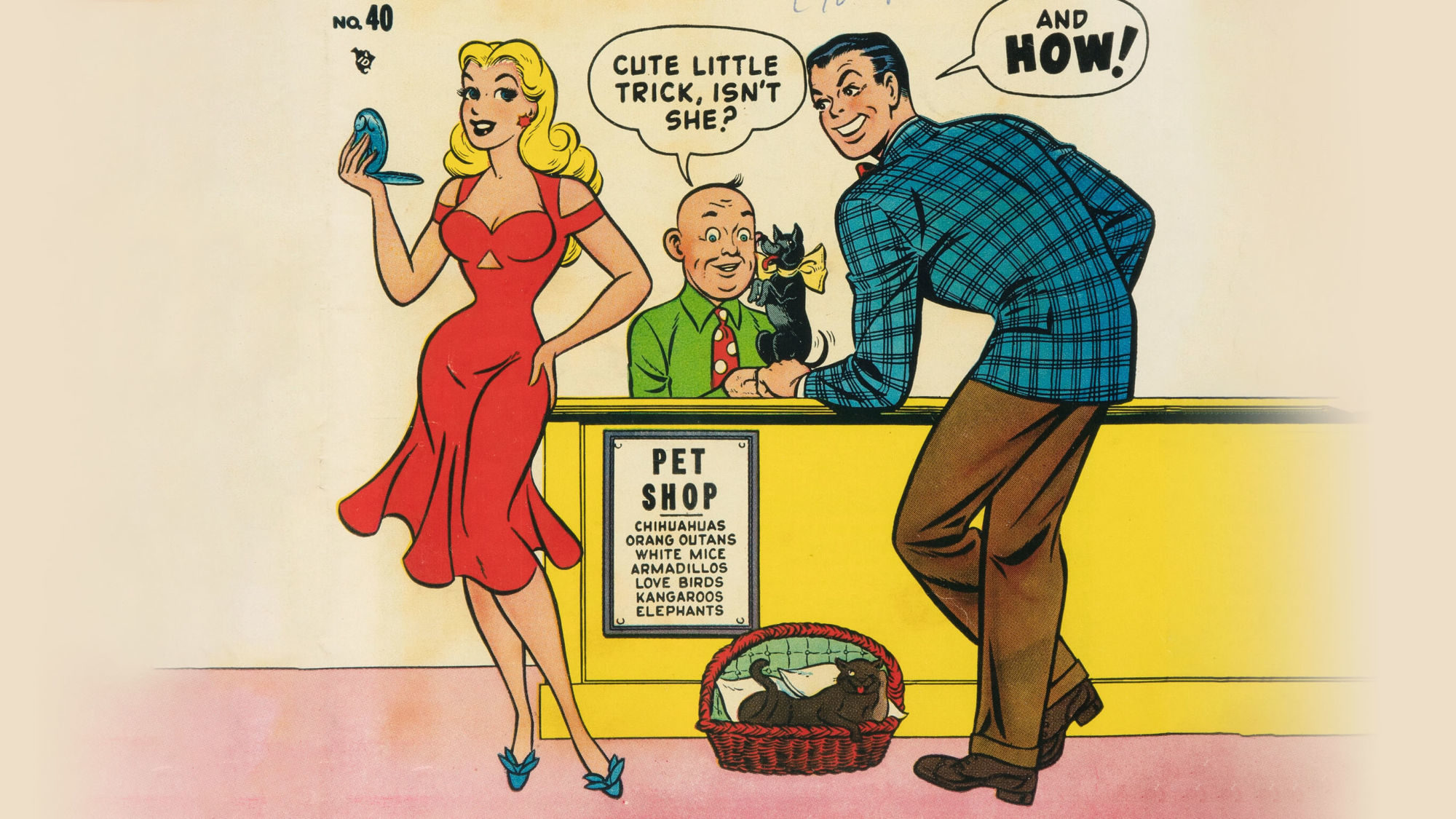On the brink of the introduciton of the Comics Code in 1954, Marvel/Atlas expanded into a market segment that Fiction House left behind.
[[{“value”:”
Home
»
»
The Star Power of Marvel’s Hedy De Vine, Up for Auction
Posted in: Comics, Heritage Sponsored, Vintage Paper | Tagged:
Not to be confused with Patsy Walker’s frenemy Hedy Wolfe, Hedy De Vine was a movie star who had her own Marvel series.
Discover the impact of the 1940s title transition on Marvel’s lineup.
Uncover how humor comics reflected women’s roles post-WWII.
Dive into the elusive creator history of Hedy De Vine Comics.
Actress/inventor Hedy Lamarr had become such a big star by the mid-1940s that her name inspired the names of two different Marvel comic book characters. Hedy Wolfe was Patsy Walker’s frenemy, first appearing in Patsy’s debut in Miss America Magazine v1 #2, and eventually getting title credit in the long-running Patsy and Hedy series. But the character Hedy De Vine was more on point with her film actress namesake, as the character was a movie star herself. Hedy De Vine was a force of nature in her stories, portrayed as the prettiest and most sought-after starlet in Hollywood. The rest of the cast of characters essentially reacted to Hedy as she followed her path through life.
Hedy of Hollywood #40 (Marvel, 1951)
The Hedy De Vine Comics series was part of the complex late-1940s title “changing of the guard” that we recently mentioned in regard to Teen Comics, as the comic book industry began to transition away from superhero titles for a time. Like Teen Comics, Hedy De Vine Comics has its roots in the All Winners Comics title. After that title was changed to All Teen Comics with issue #20, All Winners Comics then actually returned for a final issue five months later, taking over the numbering of Young Allies Comics. Finally, Hedy De Vine Comics then picked up that numbering with issue #22, essentially continuing the numbering of the classic superhero kid team-up title that had featured Captain America’s sidekick Bucky and the Human Torch’s sidekick Toro.
By the time this transition was complete in early 1947, humor characters, including the likes of Tessie the Typist, Millie the Model, and Nellie the Nurse were dominating Marvel’s output. While Hedy and the rest of these are often lumped in with Marvel’s teen humor titles, they are actually a reflection of the growing role of women in the workforce that had started during WWII. This space had been pioneered at Marvel on the Tessie the Typist stories, and many of them used a similar formula: the adventures of a woman trying to succeed at her job, a work rival, a demanding boss, a would-be boyfriend, and occasionally a roommate or best friend who grounds her. In Hedy De Vine Comics, these roles were filled by movie director Cecil Trumpetski, rival movie star Sandra Stile, and her manager, agent, and romantic interest, Gabby Dunn.
As with many similar titles, the creators of the Hedy De Vine material are largely unknown. The series ran from issues #22-35 and was then retitled Hedy of Hollywood. Like many of the Marvel humor titles of this era, the series has surprisingly low CGC census numbers, but there are several issues of both Hedy De Vine Comics and Hedy of Hollywood up for auction in 2024 October 3 – 5 Good Girl Art and Romance Comics Showcase Auction #40269.
Affiliates of Bleeding Cool buy from and/or consign to Heritage Auctions.
Enjoyed this? Please share on social media!
Stay up-to-date and support the site by following Bleeding Cool on Google News today!
Not to be confused with Patsy Walker’s frenemy Hedy Wolfe, Hedy De Vine was a movie star who had her own Marvel series.
Just as Fiction House was ending Sheena, Queen of the Jungle, Marvel launched Lorna, the Jungle Queen by Don Rico and Werner Roth.
Millie the Model’s longtime frenemy Chili Seven (later renamed Chili Storm) was introduced in a story in Millie the Model Comics #3.
John Buscema did significant work for publisher Orbit from 1950 to 1953, including several covers for their romance comic book line.
Betty, Archie, and Reggie are featured in what might be the most infamous accidental double entendre cover from vintage comics history.
A few days ago, Bleeding Cool scooped the news that in January, Marvel Comics would publish a comic called X-Men: Xavier’s Secret #1.
On the brink of the introduciton of the Comics Code in 1954, Marvel/Atlas expanded into a market segment that Fiction House left behind.
Earlier this year, the Pop Culture Marketing Trends Summit was held at MCM London Comic Con. And now it’s back.
Not to be confused with Patsy Walker’s frenemy Hedy Wolfe, Hedy De Vine was a movie star who had her own Marvel series.
I hear the goss that, ahead of an NYCC announcement, digital comics publisher and distributor GlobalComix will add DC Comics to their service
Just as Fiction House was ending Sheena, Queen of the Jungle, Marvel launched Lorna, the Jungle Queen by Don Rico and Werner Roth.
“}]] Not to be confused with Patsy Walker’s frenemy Hedy Wolfe, Hedy De Vine was a movie star who had her own Marvel series. Read More

